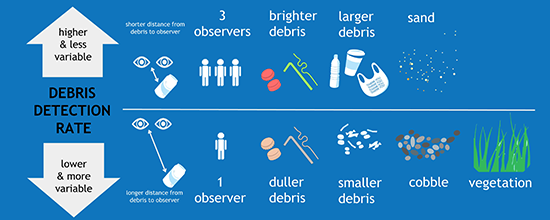How We Count Counts: A NOAA Publication on Marine Debris Detection
JAN. 8, 2024 — In early January, a new NOAA publication, How we count counts: Examining influences on detection during shoreline surveys of marine debris, was published in the journal Marine Pollution Bulletin.

Current and former NOAA Marine Debris Program (MDP) staff Hillary Burgess, Amy V. Uhrin, Carlie Herring, and Sherry Lippiatt are co-authors together with Coastal Observation and Seabird Survey Team (COASST) staff from the University of Washington. This is the product of a Fiscal Year 2018 collaborative project between the MDP and COASST through the Joint Institute for the Study of the Atmosphere and Ocean.
The research team conducted a series of field trials to simulate marine debris surveys. They deployed known amounts and types of marine debris to test factors that influence debris detection. Detection rates varied according to the distance between the debris and the observer (0–5 meters), number of observers, debris characteristics (size, color), and shoreline substrate. Findings highlight data analysis and interpretation, as well as considerations for monitoring program design. These results informed recent updates to the Marine Debris Monitoring and Assessment Project protocols, with the goal of increasing overall detection rates and reducing variability in detection among surveys to optimize future marine debris monitoring efforts.
